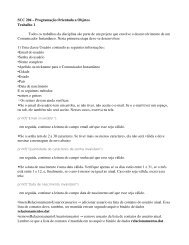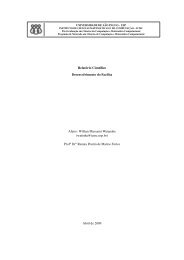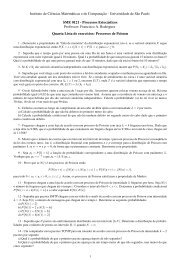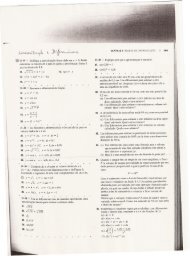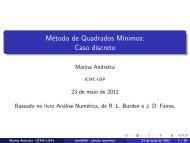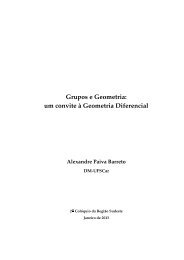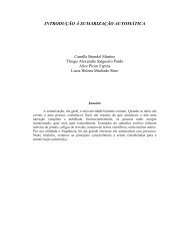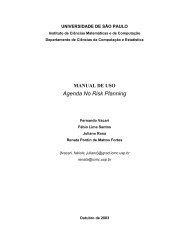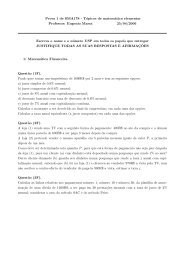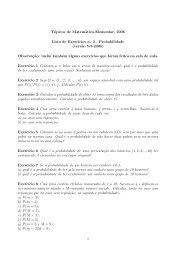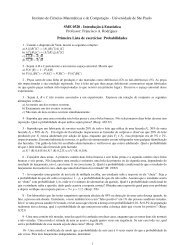Fast heuristics for the Steiner tree problem with revenues ... - ICMC
Fast heuristics for the Steiner tree problem with revenues ... - ICMC
Fast heuristics for the Steiner tree problem with revenues ... - ICMC
Create successful ePaper yourself
Turn your PDF publications into a flip-book with our unique Google optimized e-Paper software.
<strong>Fast</strong> <strong>heuristics</strong> <strong>for</strong> <strong>the</strong> <strong>Steiner</strong> <strong>tree</strong> <strong>problem</strong> <strong>with</strong><br />
Abstract<br />
<strong>revenues</strong>, budget and hop constraints<br />
Alysson M. Costa 1 , Jean-François Cordeau 2 and Gilbert Laporte 1<br />
1 Centre <strong>for</strong> Research on Transportation and<br />
Canada Research Chair in Distribution Management, HEC Montréal<br />
3000 chemin de la Côte-Sainte-Ca<strong>the</strong>rine, Montréal, Canada H3T 2A7<br />
2 Centre <strong>for</strong> Research on Transportation and<br />
Canada Research Chair in Logistics and Transportation, HEC Montréal<br />
3000 chemin de la Côte-Sainte-Ca<strong>the</strong>rine, Montréal, Canada H3T 2A7<br />
{alysson, cordeau, gilbert}@crt.umontreal.ca<br />
June 1, 2007<br />
This article describes and compares three <strong>heuristics</strong> <strong>for</strong> a variant of <strong>the</strong> <strong>Steiner</strong> <strong>tree</strong> <strong>problem</strong> <strong>with</strong> <strong>revenues</strong>,<br />
which includes budget and hop constraints. First, a greedy method which obtains good approximations<br />
in short computational times is proposed. This initial solution is <strong>the</strong>n improved by means of a destroy-<br />
and-repair method or a tabu search algorithm. Computational results compare <strong>the</strong> three methods in<br />
terms of accuracy and speed.<br />
Keywords: Prize collecting, network design, <strong>Steiner</strong> <strong>tree</strong> <strong>problem</strong>, budget, hop constraints,<br />
<strong>heuristics</strong>, tabu search.<br />
1 Introduction<br />
Network design <strong>problem</strong>s arise in a large variety of real-life situations. In particular, spanning<br />
<strong>tree</strong>s are used to model and solve planning <strong>problem</strong>s frequently encountered in telecommunica-<br />
tions (Voß, 2006) and electricity distribution (Carneiro et al., 1996; Avella et al., 2005).
The purpose of this article is to develop <strong>heuristics</strong> <strong>for</strong> <strong>the</strong> <strong>Steiner</strong> Tree Problem <strong>with</strong> Revenues,<br />
Budget and Hop Constraints (STPRBH). This <strong>problem</strong> is a generalization of several well-studied<br />
<strong>problem</strong>s such as <strong>the</strong> Minimum Spanning Tree Problem (MSTP) and <strong>the</strong> <strong>Steiner</strong> Tree Problem<br />
(STP) described as follows. Let G = (V,E) be a graph <strong>with</strong> vertex set V = {1,... ,n}, where<br />
vertex 1 is <strong>the</strong> root vertex, and edge set E = {(i,j) : i,j ∈ V,i < j}. In what follows, (i,j) must<br />
be interpreted as (j,i) if i > j. Each vertex has an associated revenue ri ≥ 0, and each edge<br />
has an associated cost cij ≥ 0. Also, let T be a <strong>tree</strong> in G, and let v(T) and e(T) be <strong>the</strong> sets of<br />
vertices and edges belonging to T, respectively. The STPRBH is <strong>the</strong> <strong>problem</strong> of determining a<br />
<strong>tree</strong> T of maximal revenue r(T) = �<br />
i∈v(T) ri, rooted at vertex 1, and subject to two constraints:<br />
a budget constraint limiting <strong>the</strong> network cost �<br />
(i,j)∈e(T) cij to a maximum value b, and hop<br />
constraints limiting <strong>the</strong> number of edges hi between i ∈ v(T) and <strong>the</strong> root vertex to a maximum<br />
value h.<br />
The STP is a well-studied <strong>problem</strong> and so is its version <strong>with</strong> <strong>revenues</strong>. The latter <strong>problem</strong><br />
is useful in situations where one must decide whe<strong>the</strong>r or not to serve certain vertices. The idea<br />
is that one is not obliged to serve all vertices as in <strong>the</strong> MST, or specified vertices as in <strong>the</strong> STP.<br />
Instead, <strong>the</strong> number and location of <strong>the</strong> vertices to be served are part of <strong>the</strong> decision <strong>problem</strong>.<br />
For example, a cable television company planning to expand its network can decide whe<strong>the</strong>r or<br />
not to serve a certain area, based on <strong>the</strong> combination of <strong>the</strong> expected <strong>revenues</strong> that will come<br />
from <strong>the</strong> clients in that area and <strong>the</strong> network expansion cost. <strong>Steiner</strong> <strong>tree</strong> <strong>problem</strong>s <strong>with</strong> <strong>revenues</strong><br />
have been used to solve design <strong>problem</strong>s in local access networks (Canuto et al., 2001; Cunha<br />
et al., 2003), and in heating networks (Ljubić et al., 2005). In network expansion <strong>problem</strong>s, one<br />
is usually faced <strong>with</strong> budgetary constraints that come from <strong>the</strong> fact that a limited investment<br />
budget is available <strong>for</strong> a certain area or a certain period of time. Although it is quite easy to<br />
understand <strong>the</strong> practical aspect of <strong>the</strong>se constraints, budget considerations are almost always<br />
ignored when dealing <strong>with</strong> STP <strong>with</strong> <strong>revenues</strong> (Costa et al., 2006b).<br />
Concerning <strong>the</strong> hop constraints, <strong>the</strong>ir inclusion enables <strong>the</strong> consideration of reliability or<br />
transmission delays in <strong>the</strong> network. LeBlanc et al. (1999) have investigated <strong>the</strong> effect of hop<br />
constraints both on <strong>the</strong> reliability and on <strong>the</strong> maintenance of <strong>the</strong> signal quality in packet-<br />
switched telecommunication networks. Gouveia and Magnanti (2003) also use hop constraints<br />
to guarantee quality of service in telecommunications networks. O<strong>the</strong>r uses of hop constraints<br />
have also been proposed in <strong>the</strong> literature. Balakrishnan and Altinkemer (1992) have imposed hop<br />
constraints to generate alternative communications networks, while Voß (1999) has mentioned<br />
<strong>the</strong> utility of <strong>the</strong>se constraints to model time durability constraints when solving some classes<br />
of lot-sizing <strong>problem</strong>s by means of spanning <strong>tree</strong> models.<br />
In this article we propose heuristic methods <strong>for</strong> <strong>the</strong> STPRBH. A previous study (Costa<br />
2
et al., 2007) has shown <strong>the</strong> limits of exact algorithms <strong>for</strong> this <strong>problem</strong>. The heuristic methods<br />
proposed here are intended to obtain good approximations <strong>for</strong> large scale <strong>problem</strong>s <strong>for</strong> which<br />
exact algorithms fail to converge. Several exact and heuristic methods already exist <strong>for</strong> <strong>the</strong> STP<br />
<strong>with</strong> profits (Costa et al., 2006b) and <strong>for</strong> spanning <strong>problem</strong>s <strong>with</strong> hop constraints but, to our<br />
knowledge, no one has ever proposed approximate algorithms <strong>for</strong> <strong>the</strong> more general STPRBH.<br />
The closest <strong>problem</strong>s solved by means of heuristic methods seem to be <strong>the</strong> MST and <strong>the</strong> STP<br />
<strong>with</strong> hop constraints. Lagrangian relaxation <strong>heuristics</strong> have been proposed <strong>for</strong> <strong>the</strong> MST <strong>with</strong><br />
hop constraints (Gouveia, 1995; Gouveia, 1996; Gouveia, 1998; Gouveia and Requejo, 2001) and<br />
<strong>for</strong> <strong>the</strong> STP <strong>with</strong> hop constraints (Gouveia, 1998), while Voß (1999) has developed a greedy<br />
method and a tabu search algorithm <strong>for</strong> <strong>the</strong> hop constrained STP.<br />
We first propose a fast greedy algorithm which is followed by one of <strong>the</strong> following two<br />
improvement phases: a simple local search that destroys part of <strong>the</strong> solution and rebuilds it<br />
in a greedy fashion, or a more flexible tabu search algorithm that explores <strong>the</strong> solution space<br />
by means of two simple neighborhoods. In <strong>the</strong> remainder of this article we describe <strong>the</strong>se<br />
three algorithms in detail. In <strong>the</strong> next section, we provide a ma<strong>the</strong>matical <strong>for</strong>mulation <strong>for</strong> <strong>the</strong><br />
STPRBH in order to help understand <strong>the</strong> ideas behind <strong>the</strong> <strong>heuristics</strong>. Then, <strong>the</strong> algorithms<br />
<strong>the</strong>mselves are described. The greedy and <strong>the</strong> destroy-and-repair approaches are presented in<br />
Sections 3 and 4, respectively. Section 5 describes <strong>the</strong> tabu search algorithm while computational<br />
results are provided in Section 6. The paper ends <strong>with</strong> some conclusions in Section 7.<br />
2 Ma<strong>the</strong>matical <strong>for</strong>mulation<br />
We first recall <strong>the</strong> undirected Dantzig-Fulkerson-Johnson model <strong>for</strong> <strong>the</strong> STPRBH presented<br />
in (Costa et al., 2007). Constraints (4) and (5) of this model are useful to understand our<br />
<strong>heuristics</strong>. Let xij and yi be binary variables associated <strong>with</strong> edges (i,j) ∈ E and vertices<br />
i ∈ V , respectively. Variable yi is equal to 1 if vertex i belongs to <strong>the</strong> solution (y1 = 1), and<br />
to 0 o<strong>the</strong>rwise. Similarly, variable xij is equal to 1 if edge (i,j) belongs to <strong>the</strong> solution, and<br />
to 0 o<strong>the</strong>rwise. For S ⊆ V , define E(S) as <strong>the</strong> set of edges <strong>with</strong> both end vertices in S. Let<br />
also P = (i1 = 1,... ,iℓ) denote a path originating at <strong>the</strong> root vertex and containing ℓ vertices.<br />
Finally, define Ph as <strong>the</strong> set of paths P <strong>with</strong> ℓ = h+2, i.e., paths <strong>with</strong> h+1 edges. The STPRBH<br />
can <strong>the</strong>n be written as:<br />
subject to<br />
Maximize �<br />
3<br />
i∈V<br />
riyi<br />
(1)
�<br />
(i,j)∈E<br />
�<br />
(i,j)∈E(S)<br />
xij = �<br />
yi − 1, (2)<br />
i∈V<br />
xij ≤ �<br />
�<br />
(i,j)∈E<br />
ℓ�<br />
t=2<br />
i∈S\{k}<br />
yi, k ∈ S ⊆ V, |S| ≥ 2, (3)<br />
cijxij ≤ b, (4)<br />
xit−1,it ≤ h, P = (i1 = 1,... ,iℓ) ∈ Ph, (5)<br />
xij ∈ {0,1}, (i,j) ∈ E, (6)<br />
y1 = 1, (7)<br />
yi ∈ {0,1}, i ∈ V \{1}. (8)<br />
The goal is to maximize <strong>the</strong> collected <strong>revenues</strong> while respecting <strong>the</strong> budget and hop con-<br />
straints, (4) and (5), respectively. Constraint (2) guarantees that in <strong>the</strong> solution <strong>the</strong> number<br />
of edges is equal to <strong>the</strong> number of vertices minus one, and constraints (3) are <strong>the</strong> connectivity<br />
constraints.<br />
3 Greedy algorithm<br />
The idea of our greedy algorithm is to iteratively construct a rooted <strong>tree</strong> while maintaining<br />
<strong>the</strong> feasibility of constraints (4) and (5). We start <strong>with</strong> a solution containing only <strong>the</strong> root vertex.<br />
At each step of <strong>the</strong> algorithm, one adds a path connecting a non-selected profitable vertex to <strong>the</strong><br />
existing solution. The algorithm stops when it cannot find a profitable vertex that can be added<br />
to <strong>the</strong> solution <strong>with</strong>out incurring a violation of ei<strong>the</strong>r <strong>the</strong> budget or <strong>the</strong> hop constraints. Two<br />
basic steps are needed to implement this idea. First, one must be able to produce feasible paths<br />
connecting non-selected profitable vertices to <strong>the</strong> existing solution. Second, one must evaluate<br />
<strong>the</strong>se paths and choose <strong>the</strong> best one (in a greedy sense). These two steps are now detailed.<br />
3.1 Finding feasible paths<br />
Adding at each step of <strong>the</strong> algorithm a path not creating cycles to <strong>the</strong> existing solution<br />
guarantees <strong>the</strong> satisfaction of constraints (2) and (3). In order to respect <strong>the</strong> budget constraint,<br />
<strong>the</strong> sum of <strong>the</strong> edge costs in <strong>the</strong> added path plus <strong>the</strong> costs of <strong>the</strong> edges already in <strong>the</strong> solution must<br />
not exceed <strong>the</strong> budget value. There<strong>for</strong>e, one has interest in finding shortest paths connecting<br />
profitable vertices to <strong>the</strong> current <strong>tree</strong>. On <strong>the</strong> o<strong>the</strong>r hand, <strong>the</strong> number of <strong>the</strong> edges in a path<br />
4
must be limited, in order to respect <strong>the</strong> hop constraints. It is important to note that it does<br />
not suffice to guarantee that <strong>the</strong> added paths have less than h edges. Instead, one must also<br />
ensure that <strong>the</strong> number of edges in <strong>the</strong> complete path from <strong>the</strong> added profitable vertex to <strong>the</strong><br />
root vertex (which might include edges that were already in <strong>the</strong> existing solution) is limited to<br />
h.<br />
Based on <strong>the</strong>se two considerations, it is easy to conclude that a building block <strong>for</strong> constructing<br />
feasible paths is <strong>the</strong> hop constrained shortest path <strong>problem</strong>, i.e., <strong>the</strong> <strong>problem</strong> of determining<br />
a shortest path between two vertices containing at most h edges. This <strong>problem</strong> can be solved<br />
efficiently by dynamic programming (Lawler, 1976). Let L(i,j,ℓ) represent <strong>the</strong> cost of a shortest<br />
path between an origin vertex i and a destination vertex j, containing at most ℓ edges. Then<br />
L(i,i,0) = 0, i ∈ V,<br />
L(i,j,0) = ∞, i,j ∈ V,j �= i,<br />
L(i,j,ℓ) = min{L(i,j,ℓ − 1),min k|(k,j)∈E{L(i,k,ℓ − 1) + ckj}, i,j ∈ V,ℓ ≥ 1.<br />
Note that, contrary to what happens in <strong>the</strong> shortest path <strong>problem</strong>, an optimal subpath<br />
between two vertices is dependent on <strong>the</strong> complete path to which it belongs. This happens due<br />
to <strong>the</strong> hop constraints, as shown in Figure 1. Costs are shown next to <strong>the</strong> edges. The figure<br />
depicts optimal shortest paths from vertex 1 to <strong>the</strong> o<strong>the</strong>r vertices in <strong>the</strong> graph, <strong>with</strong> a hop limit<br />
of 3. Consider <strong>the</strong> optimal subpath from vertex 1 to vertex 4. This subpath includes vertices<br />
2 and 3 if vertex 4 is <strong>the</strong> destination, but, in order to respect <strong>the</strong> hop limit, it includes only<br />
vertex 6 if vertex 5 is <strong>the</strong> destination. In implementation terms, this means that one must keep<br />
a precedence array <strong>for</strong> each vertex of <strong>the</strong> graph vertices while solving <strong>the</strong> <strong>problem</strong>.<br />
With an algorithm <strong>for</strong> <strong>the</strong> shortest path <strong>problem</strong> <strong>with</strong> hop constraints, one can evaluate <strong>the</strong><br />
cost of connecting <strong>the</strong> non-selected profitable vertices to <strong>the</strong> existing <strong>tree</strong> and develop a simple<br />
algorithm. Let T be <strong>the</strong> current solution. At <strong>the</strong> first iteration, v(T) = {1} and <strong>the</strong> candidate<br />
destination vertices j are those <strong>with</strong> L(1,j,h) ≤ b and rj > 0. Note that if a path violates<br />
<strong>the</strong> hop constraint, <strong>the</strong> hop constrained shortest path will return ∞, since we stop <strong>the</strong> dynamic<br />
programming algorithm after h steps. There<strong>for</strong>e, paths violating <strong>the</strong> hop constraint will not<br />
be considered <strong>for</strong> insertion in <strong>the</strong> solution. When at least one path has been added, one must<br />
not only consider <strong>the</strong> new paths that originate at <strong>the</strong> root vertex, but also all paths that are<br />
originated at o<strong>the</strong>r vertices in v(T). The algorithm considers <strong>for</strong> insertion all shortest paths<br />
such that<br />
L(i,j,h − hi) ≤ b − �<br />
(i,j)∈e(T)<br />
cij, i ∈ v(T),j /∈ v(T),rj > 0.<br />
Instead of running <strong>the</strong> hop constrained shortest path algorithm <strong>for</strong> all vertices in <strong>the</strong> current<br />
solution, we set <strong>the</strong> costs of <strong>the</strong> edges in e(T) to 0 and run <strong>the</strong> algorithm a single time, <strong>with</strong><br />
5
6<br />
5<br />
5<br />
Figure 1: Example of different optimal subpaths between two vertices depending on <strong>the</strong> complete<br />
path.<br />
<strong>the</strong> root vertex as <strong>the</strong> origin. Because of <strong>the</strong> dynamic programming structure, a single run is<br />
able to compute <strong>the</strong> hop constrained shortest distances from <strong>the</strong> root to all <strong>the</strong> o<strong>the</strong>r vertices,<br />
saving computation time.<br />
3.2 Evaluating <strong>the</strong> paths<br />
At each step, a single new path is added to <strong>the</strong> solution. The criterion used to choose <strong>the</strong><br />
path to be added is an important part of <strong>the</strong> algorithm. If one makes a choice based only on<br />
profits, <strong>the</strong>re is a risk of adding very costly paths that will soon consume <strong>the</strong> whole budget.<br />
On <strong>the</strong> o<strong>the</strong>r hand, if one chooses to add shortest paths, some vertices <strong>with</strong> a high revenue but<br />
at a moderate distance from <strong>the</strong> current solution may be ignored. Based on preliminary tests,<br />
we found that <strong>the</strong> best strategy was to consider both <strong>the</strong> costs and <strong>the</strong> <strong>revenues</strong> when deciding<br />
on <strong>the</strong> path to be added. We tested several ratios r α j /cβ , where α and β are two non-negative<br />
numbers, rj is <strong>the</strong> revenue of <strong>the</strong> profitable vertex to be added, and c is <strong>the</strong> sum of <strong>the</strong> cost of<br />
<strong>the</strong> edges in <strong>the</strong> path. We found that <strong>the</strong> best parameter setting was α = 3 and β = 1, which<br />
was used in all subsequent tests.<br />
Algorithm 1, described in <strong>the</strong> following figure, presents <strong>the</strong> complete greedy algorithm in<br />
details. A few comments on this algorithm are in order. First, note that when adding a path one<br />
can also add o<strong>the</strong>r profitable vertices in addition to <strong>the</strong> end vertex. It has proved to be slightly<br />
better not to consider <strong>the</strong>se profits when deciding which path should be added. This way, <strong>the</strong><br />
6<br />
1<br />
2<br />
3<br />
4<br />
5<br />
1<br />
1<br />
1<br />
1
Algorithm 1 Greedy algorithm <strong>for</strong> <strong>the</strong> STPRBH<br />
1: T is initially <strong>the</strong> root node: v(T) = {1}.<br />
2: p = 1;<br />
3: while p �= 0 do<br />
4: p = 0,c = 0,j = −1.<br />
5: <strong>for</strong> all vertices j /∈ v(T) do<br />
6: c = L(1,j,h);<br />
7: p = r 3 j /c.<br />
8: if �<br />
(i,j)∈e(T) cij + c > b <strong>the</strong>n<br />
9: p = 0.<br />
10: end if<br />
11: if p ≥ p <strong>the</strong>n<br />
12: j = j;<br />
13: c = c;<br />
14: p = p.<br />
15: end if<br />
16: end <strong>for</strong><br />
17: if p �= 0 <strong>the</strong>n<br />
18: P is <strong>the</strong> path from 1 to j: P = (i1 = 1,... ,iℓ = j);<br />
19: cit,it+1<br />
= 0, t = 1,... ,ℓ − 1;<br />
20: v(T) = v(T) ∪ v(P);<br />
21: destroy possible cycles.<br />
22: end if<br />
23: end while<br />
24: Return T.<br />
algorithm tends to add shorter paths first, thus reducing <strong>the</strong> risk of making wrong decisions<br />
due to <strong>the</strong> myopic character of <strong>the</strong> choices. Second, because of <strong>the</strong> hop constraints, one can<br />
sometimes introduce cycles when adding a path. Consider again Figure 1 and <strong>the</strong> situation<br />
where h = 3, all vertices are profitable and, after <strong>the</strong> first iteration of <strong>the</strong> greedy algorithm<br />
v(T) = {1,2,3,4}. Assuming that <strong>the</strong> budget constraint is not violated, <strong>the</strong> algorithm will try<br />
to add vertex 5 to <strong>the</strong> solution, using <strong>the</strong> edges (1,6) and (6,4) in order to respect <strong>the</strong> hop<br />
constraint and <strong>the</strong>re<strong>for</strong>e <strong>for</strong>ming a cycle. When this situation happens, <strong>the</strong> algorithm destroys<br />
<strong>the</strong> cycle by inspecting vertices <strong>with</strong> two incoming edges (in this case, vertex 4) and eliminating<br />
<strong>the</strong> edge that was inserted first (in this case, edge (3,4)). This way, <strong>the</strong> cycle is eliminated and<br />
<strong>the</strong> hop constraints are respected <strong>for</strong> <strong>the</strong> entire graph.<br />
7
4 Destroy-and-repair algorithm<br />
The idea of destroying part of <strong>the</strong> solution and reconstructing it in a different way in order to<br />
obtain different and hopefully better solutions has already been used to solve o<strong>the</strong>r combinatorial<br />
<strong>problem</strong>s. Ropke and Pisinger (2006) have employed such a technique to solve vehicle routing<br />
<strong>problem</strong>s <strong>with</strong> time windows, and Pisinger and Ropke (2007) have applied it to a more general<br />
class of routing <strong>problem</strong>s. Voß (1999) has successfully used a similar idea to solve <strong>the</strong> STP<br />
<strong>with</strong> hop constraints. For <strong>the</strong> STPRBH, we propose a very simple procedure that consists of<br />
sequentially blocking part of <strong>the</strong> current solution and rerunning <strong>the</strong> greedy algorithm.<br />
A feasible solution to <strong>the</strong> STPRBH consists of a <strong>tree</strong>. Given an initial solution, we simply<br />
set <strong>the</strong> cost of some edges to infinity, one at a time, and we rerun <strong>the</strong> greedy algorithm <strong>with</strong><br />
<strong>the</strong> modified costs. This is done <strong>for</strong> all edges of <strong>the</strong> current solution that are incident to a<br />
leaf vertex, as shown in Figure 2, and <strong>the</strong> best obtained solution is retained. The procedure is<br />
repeated <strong>for</strong> <strong>the</strong> new solution until <strong>the</strong>re is no gain obtained <strong>with</strong> <strong>the</strong> blocking of a single edge.<br />
Algorithm 2 schematically presents <strong>the</strong> procedure.<br />
Root vertex<br />
Figure 2: Edges incident to leaf vertices.<br />
Edges to be tested<br />
O<strong>the</strong>r ways of preventing <strong>the</strong> greedy algorithm from repeatedly reaching <strong>the</strong> same solution<br />
can be used. For example, one could block all edges in <strong>the</strong> solution, one at a time. We tested<br />
this idea and, although it was much more time consuming, <strong>the</strong> results were not much better than<br />
<strong>the</strong> ones obtained <strong>with</strong> Algorithm 2. In a way this was expected, since <strong>the</strong> greedy algorithm<br />
8
Algorithm 2 Destroy-and-repair algorithm <strong>for</strong> <strong>the</strong> STPRBH<br />
1: T = solution of Algorithm 1;<br />
2: best solution T = T.<br />
3: y = true<br />
4: while y = true do<br />
5: y = false<br />
6: <strong>for</strong> all <strong>the</strong> edges (i,j) incident to a leaf vertex do<br />
7: store original cost: cij = cij;<br />
8: cij = ∞;<br />
9: T = solution of Algorithm 1 (<strong>with</strong> modified costs).<br />
10: if r(T) > r(T) <strong>the</strong>n<br />
11: y = true<br />
12: T = T.<br />
13: end if<br />
14: Restore original cost: cij = cij.<br />
15: end <strong>for</strong><br />
16: end while<br />
17: T = T;<br />
18: return T<br />
has a tendency to reconstruct a similar solution if an intermediate edge has been blocked. By<br />
concentrating on <strong>the</strong> edges incident to profitable leaf vertices we increase <strong>the</strong> probability of really<br />
blocking that solution and obtaining something new.<br />
We also tested o<strong>the</strong>r neighborhoods such as blocking a vertex of <strong>the</strong> solution (by setting <strong>the</strong><br />
cost of all its incident edges to infinity). The results turned out to be worse than those obtained<br />
<strong>with</strong> <strong>the</strong> original algorithm. In this case, we think that <strong>the</strong> explanation comes from <strong>the</strong> fact<br />
that blocking a vertex is probably too restrictive and by doing so we may eliminate several good<br />
solutions. Finally, we have also tested <strong>the</strong> possibility of blocking more than one arc at <strong>the</strong> same<br />
time. Although minor improvements were obtained, <strong>the</strong> computational times were considerably<br />
larger and this option was also discarded.<br />
5 Tabu search algorithm<br />
A tabu search algorithm was also developed <strong>for</strong> <strong>the</strong> STPRBH. The main idea of tabu search<br />
is to define a neighborhood <strong>for</strong> a solution and let <strong>the</strong> algorithm explore <strong>the</strong> search space by<br />
moving to <strong>the</strong> best allowed neighbor solutions, while defining some <strong>for</strong>bidden or tabu moves in<br />
9
order to avoid cycling.<br />
We define two basic moves <strong>for</strong> <strong>the</strong> STPRBH. The first is an add move. It consists of adding<br />
a path originating at a vertex of <strong>the</strong> current solution and ending at a profitable vertex. This<br />
is very similar to <strong>the</strong> basic step of <strong>the</strong> greedy algorithm presented in Section 3, since this move<br />
also makes use of <strong>the</strong> shortest path <strong>with</strong> hop constraints procedure and, <strong>the</strong>re<strong>for</strong>e, maintains<br />
hop-feasibility during <strong>the</strong> whole search. In order to increase <strong>the</strong> flexibility of <strong>the</strong> algorithm, we<br />
let <strong>the</strong> add move violate <strong>the</strong> budget constraint. The idea is to design an algorithm capable of<br />
exploring infeasible parts of <strong>the</strong> search space in <strong>the</strong> hope of reaching feasible solutions that could<br />
not be reached o<strong>the</strong>rwise. To encourage <strong>the</strong> identification of feasible solutions during <strong>the</strong> search,<br />
a penalty is associated <strong>with</strong> <strong>tree</strong>s that violate <strong>the</strong> budget. The idea of letting <strong>the</strong> tabu search<br />
explore infeasible areas of <strong>the</strong> search space has been used successfully in o<strong>the</strong>r combinatorial<br />
<strong>problem</strong>s (see, e.g., Gendreau et al., 1994).<br />
The second move is remove, which consists of <strong>the</strong> deletion of a branch of <strong>the</strong> solution. It is<br />
<strong>the</strong> counterpart of <strong>the</strong> add move in <strong>the</strong> sense that <strong>the</strong> add move is driven by revenue collection,<br />
while <strong>the</strong> remove move is driven by budget feasibility. In <strong>the</strong> following, <strong>the</strong> two moves are<br />
described in detail. A third move, which is called destroy is also described. We have used this<br />
move only occasionally to help <strong>the</strong> search algorithm escape from local optima.<br />
With respect to several tabu search implementations developed <strong>for</strong> <strong>the</strong> solution of combina-<br />
torial optimization <strong>problem</strong>s, our algorithm is relatively simple. This is a deliberate choice. In<br />
line <strong>with</strong> Cordeau et al. (2002), we believe it is preferable to design algorithms that are both<br />
accurate and simple. This makes <strong>the</strong>m easy to reproduce and it favours <strong>the</strong>ir adoption by o<strong>the</strong>r<br />
researchers.<br />
5.1 Add move<br />
An add move is like a single step of <strong>the</strong> greedy algorithm described in Section 3: one adds <strong>the</strong><br />
hop constrained shortest path connecting <strong>the</strong> best non-selected vertex to <strong>the</strong> current <strong>tree</strong>. This<br />
is done by setting <strong>the</strong> edge costs in <strong>the</strong> current solution to 0 and running <strong>the</strong> hop constrained<br />
shortest path procedure, which returns <strong>the</strong> hop constrained shortest paths originating at <strong>the</strong><br />
root and ending at each vertex of <strong>the</strong> graph. Once a vertex has been added, it is declared tabu<br />
<strong>for</strong> a number of iterations. This way, <strong>the</strong> branch connecting <strong>the</strong> previous solution to <strong>the</strong> newly<br />
added vertex will not be deleted by <strong>the</strong> remove move until its tabu status has been lifted.<br />
The tabu mechanism helps avoid cycling and <strong>for</strong>ces <strong>the</strong> algorithm to explore new areas of<br />
<strong>the</strong> search space, differentiating <strong>the</strong> tabu search from <strong>the</strong> greedy algorithm presented earlier.<br />
Ano<strong>the</strong>r strategy is used to increase <strong>the</strong> diversification of <strong>the</strong> solutions. At each iteration,<br />
one considers only a subset of randomly selected vertices: <strong>the</strong> algorithm arbitrarily chooses a<br />
10
subset of <strong>the</strong> possible vertices and adds <strong>the</strong> best one. Note that this is not done to save any<br />
computational time since <strong>the</strong> needed in<strong>for</strong>mation was already available from <strong>the</strong> hop constrained<br />
shortest path procedure even <strong>for</strong> <strong>the</strong> discarded vertices, but as a diversification mechanism.<br />
5.2 Remove move<br />
The remove move consists of eliminating branches of <strong>the</strong> current solution. It was made<br />
necessary as a counterpart of <strong>the</strong> add move in order to help <strong>the</strong> algorithm identify budget-<br />
feasible solutions. We carefully select <strong>the</strong> branches to be eliminated in order to introduce only<br />
local perturbations in <strong>the</strong> current solution. This is done by connecting a vertex <strong>with</strong> degree<br />
larger or equal to three to a leaf of <strong>the</strong> current <strong>tree</strong>. For a current solution T, we call B(T) <strong>the</strong><br />
set of vertices <strong>with</strong> degree larger or equal to three. These vertices are called breaking points,<br />
since it is at <strong>the</strong>se vertices that <strong>the</strong> solution is cut. Figure 3 depicts an example of a <strong>tree</strong> solution.<br />
The breaking points are highlighted while <strong>the</strong> possible paths to be cut are shown in dotted lines.<br />
Root vertex<br />
Breaking points<br />
Figure 3: Breaking points and possible paths to be removed<br />
11
5.3 Destroy move<br />
A destroy move that erases a whole sub<strong>tree</strong> of <strong>the</strong> current solution has also been developed.<br />
This move acts by randomly selecting a vertex in <strong>the</strong> current solution and deleting <strong>the</strong> whole<br />
sub<strong>tree</strong> rooted at that vertex. This move was only used after <strong>the</strong> algorithm spent a certain<br />
number of iterations <strong>with</strong>out improving <strong>the</strong> best known solution value.<br />
The three moves just described have been incorporated <strong>with</strong>in <strong>the</strong> tabu search algorithm.<br />
The add and remove moves are evaluated toge<strong>the</strong>r. First, <strong>the</strong> gain of all add moves is com-<br />
puted. The gain of one add move connecting <strong>the</strong> profitable vertex i to <strong>the</strong> solution is given by<br />
<strong>the</strong> value of <strong>the</strong> revenue of <strong>the</strong> added vertex, minus <strong>the</strong> difference between <strong>the</strong> penalties after<br />
and be<strong>for</strong>e <strong>the</strong> move:<br />
γ + i = ri − π(T ′ ) + π(T ′′ ),<br />
where π(T) is <strong>the</strong> penalty associated <strong>with</strong> a solution T, and T ′ and T ′′ are <strong>the</strong> solutions be<strong>for</strong>e<br />
and after <strong>the</strong> move, respectively. For a given solution T <strong>with</strong> total network cost �<br />
(i,j)∈e(T) cij,<br />
<strong>the</strong> penalty is given by:<br />
⎧<br />
⎨<br />
π(T) =<br />
⎩<br />
0, if �<br />
(i,j)∈e(T) cij ≤ b<br />
�� φ × (i,j)∈e(T) cij<br />
�<br />
− b , if �<br />
(i,j)∈e(T) cij > b,<br />
where φ is a penalty parameter updated dynamically during <strong>the</strong> search. The parameter φ is<br />
initialized at 1, but <strong>the</strong> algorithm is robust <strong>with</strong> respect to this parameter.<br />
In a complementary manner, <strong>the</strong> remove move <strong>for</strong> a node i ∈ B(T) yields a gain equal to:<br />
γ − i = −ri − π(T ′ ) + π(T ′′ ).<br />
At each iteration, <strong>the</strong> move <strong>with</strong> <strong>the</strong> best gain is per<strong>for</strong>med and <strong>the</strong> penalty parameter φ<br />
is updated. If <strong>the</strong> new solution is budget feasible, φ is halved, thus encouraging <strong>the</strong> algorithm<br />
to look <strong>for</strong> budget-infeasible solutions. Similarly, if <strong>the</strong> new solution is budget-infeasible, φ is<br />
doubled.<br />
Algorithm 3 presents <strong>the</strong> tabu search algorithm in detail. It stops after a preset number<br />
of iterations.<br />
6 Computational experiments<br />
We have tested <strong>the</strong> algorithms just described on several instances obtained from <strong>the</strong> OR-<br />
Library (Beasley, 1990). The STP instances contain two set of vertices: mandatory vertices<br />
which must be present in <strong>the</strong> solution, and <strong>Steiner</strong> vertices which can be used if <strong>the</strong>ir inclusion<br />
in <strong>the</strong> solution reduces <strong>the</strong> total cost. We have adapted <strong>the</strong>se instances <strong>for</strong> <strong>the</strong> STTPBH by<br />
12
Algorithm 3 Tabu search algorithm <strong>for</strong> <strong>the</strong> STPRBH<br />
1: T = solution of Algorithm 1;<br />
2: T = T;<br />
3: φ = 1.<br />
4: while stopping criterion not reached do<br />
5: Randomly select a subset R(T) of <strong>the</strong> profitable vertices not in <strong>the</strong> <strong>tree</strong> and compute gain,<br />
γ + i = ri − π(T ′ ) + π(T ′′ ),i ∈ R(T);<br />
6: compute gain <strong>for</strong> all remove moves, γ − i = −ri − π(T ′ ) + π(T ′′ ),i ∈ B(T);<br />
7: per<strong>for</strong>m move <strong>with</strong> best gain (γ − i or γ+ i ) and update T;<br />
8: make move tabu <strong>for</strong> 5 iterations.<br />
9: if solution is budget-feasible <strong>the</strong>n<br />
10: φ = φ/2.<br />
11: if r(T) > r(T) <strong>the</strong>n<br />
12: T = T.<br />
13: end if<br />
14: else<br />
15: φ = 2φ.<br />
16: end if<br />
17: if no improvement in more than 100 iterations <strong>the</strong>n<br />
18: apply destroy move.<br />
19: end if<br />
20: end while<br />
using <strong>the</strong> mandatory vertices as profitable vertices <strong>with</strong> revenue given by a discrete uni<strong>for</strong>m<br />
distribution on 1 and 100. The <strong>Steiner</strong> vertices were attributed a zero revenue. Different values<br />
<strong>for</strong> <strong>the</strong> budget and <strong>for</strong> <strong>the</strong> hop limit were attributed to each instance, thus creating several<br />
scenarios.<br />
Table 1 summarizes <strong>the</strong> results obtained <strong>for</strong> a mid-sized group of 144 instances, ranging<br />
from 50 to 500 vertices and from 63 to 625 edges. Note that <strong>for</strong> <strong>the</strong>se instances, <strong>the</strong> exact<br />
methods presented by Costa et al. (2007) were able to converge <strong>with</strong>in a time limit of two hours,<br />
allowing <strong>the</strong>m to be used as benchmarks to evaluate <strong>the</strong> approximate algorithms. In <strong>the</strong> table,<br />
<strong>for</strong> each method (greedy algorithm, destroy-and-repair and tabu search), we report <strong>the</strong> mean<br />
and maximum gap, as well as <strong>the</strong> mean and maximum computation times. There are two entries<br />
<strong>for</strong> <strong>the</strong> Tabu search algorithm, each corresponding to a maximum allowed number of iterations<br />
(2000 or 10,000). Complete results can be found in Costa et al. (2006a).<br />
Even <strong>the</strong> simplest of <strong>the</strong> three algorithms can solve a large number of instances to optimality.<br />
13
Method Gap Max Gap Seconds Max seconds<br />
Greedy 2.50 % 31.97 % < 0.01 0.02<br />
Destroy-and-repair 1.13 % 10.10 % 0.09 1.44<br />
Tabu (2000) 0.52 ± 0.08 % 12.99 ± 7.55 % 0.38 0.90<br />
Tabu (10,000) 0.24 ± 0.05 % 8.46 ± 8.01 % 1.80 4.21<br />
Table 1: Summary of results <strong>for</strong> <strong>the</strong> mid-sized instances<br />
Indeed, <strong>the</strong> greedy algorithm finds an optimal solution <strong>for</strong> 73 out of <strong>the</strong> 144 instances. Note that<br />
we did not consider instances <strong>with</strong> a budget equal to <strong>the</strong> total network cost since <strong>the</strong>se instances<br />
are easy and <strong>the</strong> greedy algorithm always finds an optimal solution. It is clear, however, that<br />
<strong>for</strong> some instances <strong>the</strong> greedy algorithm can be trapped in a poor quality local optimum. In <strong>the</strong><br />
worst of <strong>the</strong> cases, <strong>the</strong> algorithm generated a solution <strong>with</strong> an optimality gap almost equal to<br />
32%. Finally, concerning <strong>the</strong> computational time, since <strong>the</strong> algorithm is based on quick shortest<br />
paths calculations, a maximum of 0.02 seconds was required to solve any instance.<br />
Starting from <strong>the</strong> solution of <strong>the</strong> greedy algorithm, both <strong>the</strong> destroy-and-repair and <strong>the</strong> tabu<br />
search were able to reduce <strong>the</strong> optimality gaps. The first method reduced <strong>the</strong> mean gap from<br />
2.50% to 1.13% and <strong>the</strong> maximum gap from 32% to 10.10%. The tabu search was able to fur<strong>the</strong>r<br />
reduce <strong>the</strong>se gaps. The mean gap (averaged over ten runs) was reduced to 0.52% when 2000<br />
iterations were allowed, and to 0.24% when 10,000 iterations were allowed. The maximum gaps<br />
<strong>for</strong> <strong>the</strong>se two cases were 12.99% and 8.46%.<br />
To better evaluate <strong>the</strong> efficiency of <strong>the</strong> improvement routines, we consider a second group<br />
of larger instances <strong>with</strong> up to 500 vertices and 12,500 edges. For <strong>the</strong>se instances, <strong>the</strong> exact<br />
algorithms described in Costa et al. (2007) generally did not obtain solutions <strong>with</strong>in <strong>the</strong> allowed<br />
time limit of two hours, often failing to even solve <strong>the</strong> linear relaxation at <strong>the</strong> root node. For this<br />
reason, we compare <strong>the</strong> results obtained by <strong>the</strong> destroy-and-repair and <strong>the</strong> tabu search methods<br />
to <strong>the</strong> results obtained by <strong>the</strong> greedy algorithm. Table 2 presents a summary of <strong>the</strong> results. We<br />
can see that even <strong>for</strong> large instances, <strong>the</strong> greedy algorithm is very fast, taking on average 1.94<br />
seconds, <strong>with</strong> a maximum of 31.78 seconds. Still concerning <strong>the</strong> times, it is interesting to see<br />
how <strong>the</strong> destroy-and-repair can easily become very computationally inefficient, taking almost<br />
two hours to solve some of <strong>the</strong> instances. The tabu search, even when run <strong>for</strong> 10,000 iterations,<br />
is on average 30% faster than <strong>the</strong> destroy-and-repair algorithm and presents much more stable<br />
computing times. The complete set of results is presented in Costa et al. (2006a).<br />
Concerning <strong>the</strong> improvements, <strong>the</strong> destroy-and-repair algorithm yields mean and maximum<br />
improvements of 1.31% and 14.36%, respectively. The tabu search can increase <strong>the</strong>se percentages<br />
to 1.41% and 20.80% when run <strong>for</strong> 2000 iterations, and obtains considerably better solutions<br />
14
Method Improvement Max improvement Seconds Max seconds<br />
Greedy - - 1.94 31.78<br />
Destroy-and-repair 1.31 % 14.36 % 312.50 6493.60<br />
Tabu (2000) 1.41 ± 0.06 % 20.80 ± 2.60 % 44.98 287.64<br />
Tabu (10,000) 2.00 ± 0.04 % 23.05 ± 2.14 % 237.53 1668.6<br />
Table 2: Summary of results <strong>for</strong> <strong>the</strong> larger instances<br />
when 10,000 iterations are allowed. It <strong>the</strong>n yields 2.00% average improvement in comparison to<br />
<strong>the</strong> greedy algorithm, and a maximum improvement of more than 23%.<br />
7 Conclusions<br />
We have proposed three <strong>heuristics</strong> <strong>for</strong> a modified version of <strong>the</strong> <strong>Steiner</strong> Tree Problem <strong>with</strong><br />
<strong>revenues</strong> including budget and hop constraints. A <strong>for</strong>mer study (Costa et al., 2007) has shown<br />
that exact algorithms based on existing <strong>for</strong>mulations cannot be applied to large instances of<br />
this <strong>problem</strong>. The <strong>heuristics</strong> we have proposed are based on simple construction and tabu<br />
search mechanisms. The greedy algorithm is extremely fast but may be trapped in a local<br />
optimum due to its myopic nature. The destroy-and-repair method is a simple modification<br />
of <strong>the</strong> greedy algorithm which considerably improves its solutions, albeit at <strong>the</strong> cost of a large<br />
increase in computation time. Finally, <strong>the</strong> tabu search is capable of consistently identifying<br />
optimal solutions while maintaining <strong>the</strong> computational times at a reasonable level.<br />
Acknowledgments<br />
This work was supported by <strong>the</strong> Brazilian Federal Agency <strong>for</strong> Post-Graduate Education -<br />
CAPES, under grant BEX 1097/01-6 and by <strong>the</strong> Canadian Natural Science and Engineering<br />
Research Council under grants 227837-04 and OGP0039682. This support is gratefully acknowl-<br />
edged. The authors also thank three anonymous referees <strong>for</strong> <strong>the</strong>ir valuable comments.<br />
References<br />
Avella, P., Villacci, D. and S<strong>for</strong>za, A. (2005). A <strong>Steiner</strong> arborescence model <strong>for</strong> <strong>the</strong> feeder<br />
reconfiguration in electric distribution networks, European Journal of Operational Research<br />
164: 505–509.<br />
Balakrishnan, A. and Altinkemer, K. (1992). Using a hop-constrained model to generate alter-<br />
native communication network design, ORSA Journal on Computing 4: 192–205.<br />
15
Beasley, J. E. (1990). OR-Library: Distributing test <strong>problem</strong>s by electronic mail, Journal of <strong>the</strong><br />
Operational Research Society 41: 1069–1072.<br />
Canuto, S. A., Resende, M. G. C. and Ribeiro, C. C. (2001). Local search <strong>with</strong> perturbations<br />
<strong>for</strong> <strong>the</strong> prize-collecting <strong>Steiner</strong> <strong>tree</strong> <strong>problem</strong> in graphs, Networks 38: 50–58.<br />
Carneiro, M. S., França, P. and Silveira, P. D. (1996). Long-range planning of power distribution<br />
systems: secondary networks, Computers and Electrical Engineering 22(3): 179–191.<br />
Cordeau, J.-F., Gendreau, M., Laporte, G., Potvin, J.-Y. and Semet, F. (2002). A guide to<br />
vehicle routing <strong>heuristics</strong>, Journal of <strong>the</strong> Operational Research Society 53: 512–522.<br />
Costa, A. M., Cordeau, J.-F. and Laporte, G. (2006a). <strong>Fast</strong> <strong>heuristics</strong> <strong>for</strong> <strong>the</strong> <strong>Steiner</strong> <strong>tree</strong><br />
<strong>problem</strong> <strong>with</strong> <strong>revenues</strong>, budget and hop constraints, Publication CRT-2006-16, Centre <strong>for</strong><br />
Research on Transportation, Montreal .<br />
Costa, A. M., Cordeau, J.-F. and Laporte, G. (2006b). <strong>Steiner</strong> <strong>tree</strong> <strong>problem</strong>s <strong>with</strong> profits,<br />
INFOR 44: 99–115.<br />
Costa, A. M., Cordeau, J.-F. and Laporte, G. (2007). Models and branch-and-cut algorithms<br />
<strong>for</strong> <strong>the</strong> <strong>Steiner</strong> <strong>tree</strong> <strong>problem</strong> <strong>with</strong> <strong>revenues</strong>, budget and hop constraints, Networks (<strong>for</strong>th-<br />
coming) .<br />
Cunha, A. S., Lucena, A., Maculan, N. and Resende, M. G. C. (2003). A relax and cut al-<br />
gorithm <strong>for</strong> <strong>the</strong> prize collecting <strong>Steiner</strong> <strong>problem</strong> in graphs, Proceedings of Ma<strong>the</strong>matical<br />
Programming in Rio, Búzios, Brazil : 72–78.<br />
Gendreau, M., Hertz, A. and Laporte, G. (1994). A tabu search heuristic <strong>for</strong> <strong>the</strong> vehicle routing<br />
<strong>problem</strong>, Management Science 40: 1276–1290.<br />
Gouveia, L. (1995). Using <strong>the</strong> Miller-Tucker-Zemlin constraints to <strong>for</strong>mulate a minimal spanning<br />
<strong>tree</strong> <strong>problem</strong> <strong>with</strong> hop constraints, Computers & Operations Research 22: 959–970.<br />
Gouveia, L. (1996). Multicommodity flow models <strong>for</strong> spanning <strong>tree</strong>s <strong>with</strong> hop constraints,<br />
European Journal of Operational Research 95: 178–190.<br />
Gouveia, L. (1998). Using variable redefinition <strong>for</strong> computing lower bounds <strong>for</strong> minimum span-<br />
ning and <strong>Steiner</strong> <strong>tree</strong>s <strong>with</strong> hop constraints, INFORMS Journal on Computing 10: 180–188.<br />
Gouveia, L. and Magnanti, T. L. (2003). Network flow models <strong>for</strong> designing diameter-constrained<br />
minimum-spanning and <strong>Steiner</strong> <strong>tree</strong>s, Networks 41: 159–173.<br />
16
Gouveia, L. and Requejo, C. (2001). A new Lagrangean relaxation approach <strong>for</strong> <strong>the</strong> hop-<br />
constrained minimum spanning <strong>tree</strong> <strong>problem</strong>, European Journal of Operational Research<br />
132: 539–552.<br />
Lawler, E. (1976). Combinatorial Optimization: Networks and Matroids, Holt, Rinehart and<br />
Winston, New York.<br />
LeBlanc, L., Chifflet, J. and Mahey, P. (1999). Packet routing in telecommunication networks<br />
<strong>with</strong> path and flow restrictions., INFORMS Journal on Computing 11: 188–197.<br />
Ljubić, I., Weiskircher, R., Pferschy, U., Klau, G., Mutzel, P. and Fischetti, M. (2005). Solving<br />
<strong>the</strong> prize-collecting <strong>Steiner</strong> <strong>tree</strong> <strong>problem</strong> to optimality, Proceedings of ALENEX, Seventh<br />
Workshop on Algorithm Engineering and Experiments, Vancouver .<br />
Pisinger, D. and Ropke, S. (2007). A general heuristic <strong>for</strong> vehicle routing <strong>problem</strong>s, Computers<br />
& Operations Research (<strong>for</strong>thcoming) .<br />
Ropke, S. and Pisinger, D. (2006). An adaptive large neighborhood search heuristic <strong>for</strong> <strong>the</strong><br />
pickup and delivery <strong>problem</strong> <strong>with</strong> time windows, Transportation Science (<strong>for</strong>thcoming) .<br />
Voß, S. (1999). The <strong>Steiner</strong> <strong>tree</strong> <strong>problem</strong> <strong>with</strong> hop constraints, Annals of Operations Research<br />
86: 321–345.<br />
Voß, S. (2006). <strong>Steiner</strong> <strong>tree</strong> <strong>problem</strong>s in telecomunications, in P. Pardalos and M. G. C. Resende<br />
(eds), Handbooks of Telecommunications, Springer, New York .<br />
17



